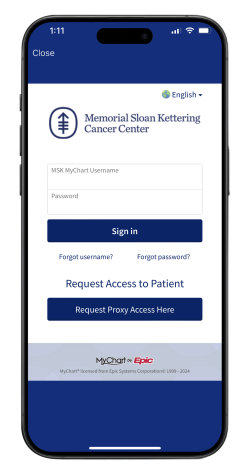This information explains your Goals to Discharge checklist. It also explains how to use it on your smartphone or tablet.
What is the Goals to Discharge checklist?
When your surgery is over, you’ll focus on getting well enough to leave the hospital. We’ll send a Goals to Discharge checklist to your MSK MyChart account to help you track how you’re doing. You can use this electronic checklist to see the goals you need to meet before leaving the hospital. You can also update your progress throughout the day. Your updates will send alerts to your surgical team about your progress.
How do I use it?
You must be signed up for MSK MyChart, MSK’s patient portal. You can access MSK MyChart at MSKMyChart.mskcc.org or by downloading the MSK MyChart app.
- If you are not enrolled in MSK MyChart, ask your care team to send you an invitation. You can also go to MSK MyChart and select “Sign up now.”
- If you aren’t sure if you signed up for MSK MyChart or don’t remember how to use it, ask a member of your care team.
The morning after your surgery, you’ll get an email telling you that you have a new assessment to fill out.
- Tap the link in the email or open the MSK MyChart app. Log in (see Figure 1).

Figure 1. MSK MyChart log in
- Tap the Menu icon in the top left corner. The Menu icon appears as 3 lines.
- Scroll down to My Record and select “Questionnaires” (see Figure 2).

Figure 2. Select “Questionnaires” from list
- Tap the questionnaire labeled “Goals to Discharge.” Answer the questions.
You can update your Goals to Discharge checklist as often as you need to.
What happens to the information I enter?
Your responses will be sent to your surgical care team. They’ll review your responses to make sure your recovery is going as expected.
What if I have questions?
- If you have questions about your Goals to Discharge checklist talk with your care team.
- If you have questions about your surgery or questions after you’ve had your surgery, contact a member of your surgical care team.
